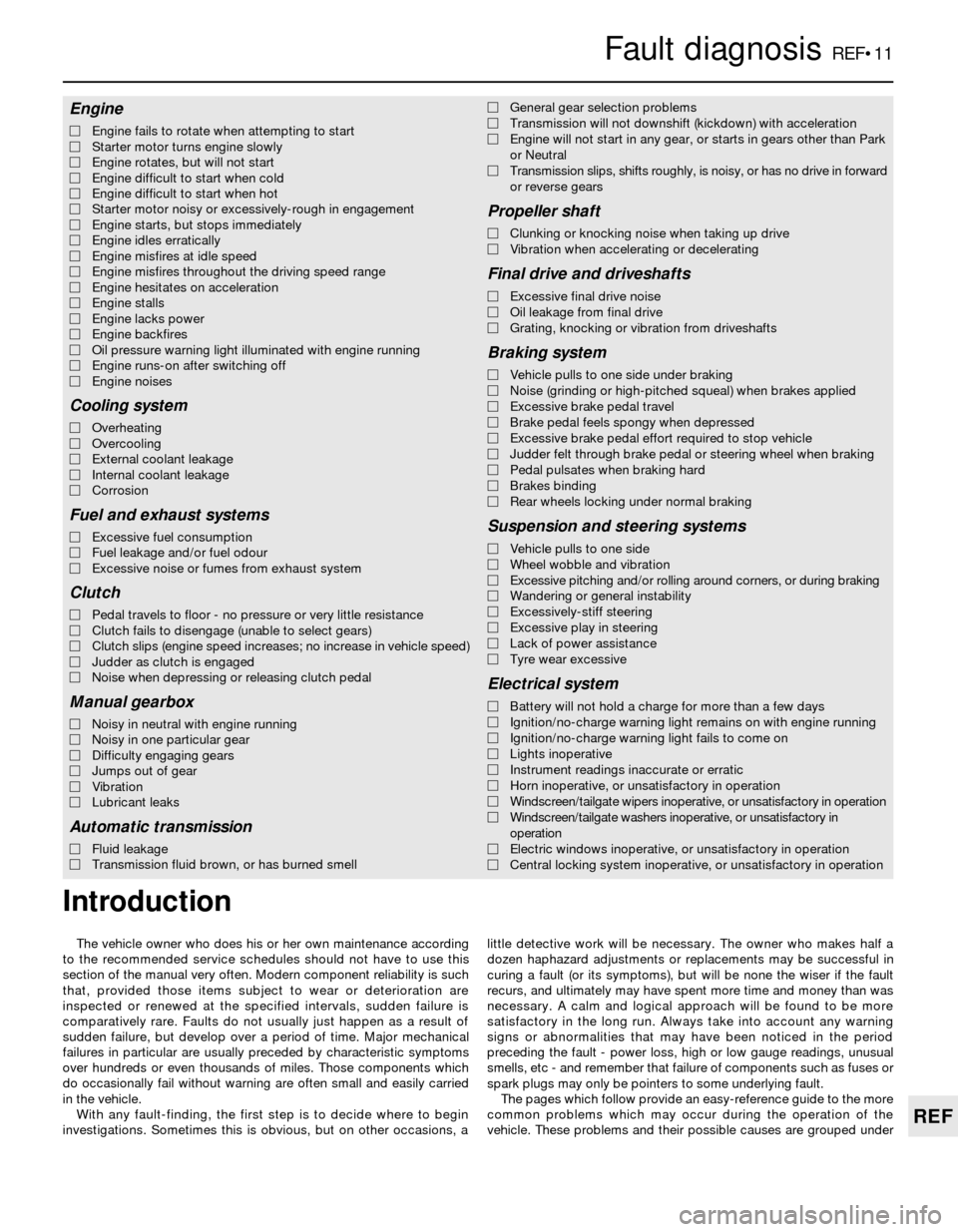heating FORD SIERRA 1982 1.G Reference Workshop Manual
[x] Cancel search | Manufacturer: FORD, Model Year: 1982, Model line: SIERRA, Model: FORD SIERRA 1982 1.GPages: 26, PDF Size: 0.57 MB
Page 11 of 26

The vehicle owner who does his or her own maintenance according
to the recommended service schedules should not have to use this
section of the manual very often. Modern component reliability is such
that, provided those items subject to wear or deterioration are
inspected or renewed at the specified intervals, sudden failure is
comparatively rare. Faults do not usually just happen as a result of
sudden failure, but develop over a period of time. Major mechanical
failures in particular are usually preceded by characteristic symptoms
over hundreds or even thousands of miles. Those components which
do occasionally fail without warning are often small and easily carried
in the vehicle.
With any fault-finding, the first step is to decide where to begin
investigations. Sometimes this is obvious, but on other occasions, alittle detective work will be necessary. The owner who makes half a
dozen haphazard adjustments or replacements may be successful in
curing a fault (or its symptoms), but will be none the wiser if the fault
recurs, and ultimately may have spent more time and money than was
necessary. A calm and logical approach will be found to be more
satisfactory in the long run. Always take into account any warning
signs or abnormalities that may have been noticed in the period
preceding the fault - power loss, high or low gauge readings, unusual
smells, etc - and remember that failure of components such as fuses or
spark plugs may only be pointers to some underlying fault.
The pages which follow provide an easy-reference guide to the more
common problems which may occur during the operation of the
vehicle. These problems and their possible causes are grouped under
Fault diagnosisREF•11
REF
Engine
MEngine fails to rotate when attempting to start
MStarter motor turns engine slowly
MEngine rotates, but will not start
MEngine difficult to start when cold
MEngine difficult to start when hot
MStarter motor noisy or excessively-rough in engagement
MEngine starts, but stops immediately
MEngine idles erratically
MEngine misfires at idle speed
MEngine misfires throughout the driving speed range
MEngine hesitates on acceleration
MEngine stalls
MEngine lacks power
MEngine backfires
MOil pressure warning light illuminated with engine running
MEngine runs-on after switching off
MEngine noises
Cooling system
MOverheating
MOvercooling
MExternal coolant leakage
MInternal coolant leakage
MCorrosion
Fuel and exhaust systems
MExcessive fuel consumption
MFuel leakage and/or fuel odour
MExcessive noise or fumes from exhaust system
Clutch
MPedal travels to floor - no pressure or very little resistance
MClutch fails to disengage (unable to select gears)
MClutch slips (engine speed increases; no increase in vehicle speed)
MJudder as clutch is engaged
MNoise when depressing or releasing clutch pedal
Manual gearbox
MNoisy in neutral with engine running
MNoisy in one particular gear
MDifficulty engaging gears
MJumps out of gear
MVibration
MLubricant leaks
Automatic transmission
MFluid leakage
MTransmission fluid brown, or has burned smellMGeneral gear selection problems
MTransmission will not downshift (kickdown) with acceleration
MEngine will not start in any gear, or starts in gears other than Park
or Neutral
MTransmission slips, shifts roughly, is noisy, or has no drive in forward
or reverse gears
Propeller shaft
MClunking or knocking noise when taking up drive
MVibration when accelerating or decelerating
Final drive and driveshafts
MExcessive final drive noise
MOil leakage from final drive
MGrating, knocking or vibration from driveshafts
Braking system
MVehicle pulls to one side under braking
MNoise (grinding or high-pitched squeal) when brakes applied
MExcessive brake pedal travel
MBrake pedal feels spongy when depressed
MExcessive brake pedal effort required to stop vehicle
MJudder felt through brake pedal or steering wheel when braking
MPedal pulsates when braking hard
MBrakes binding
MRear wheels locking under normal braking
Suspension and steering systems
MVehicle pulls to one side
MWheel wobble and vibration
MExcessive pitching and/or rolling around corners, or during braking
MWandering or general instability
MExcessively-stiff steering
MExcessive play in steering
MLack of power assistance
MTyre wear excessive
Electrical system
MBattery will not hold a charge for more than a few days
MIgnition/no-charge warning light remains on with engine running
MIgnition/no-charge warning light fails to come on
MLights inoperative
MInstrument readings inaccurate or erratic
MHorn inoperative, or unsatisfactory in operation
MWindscreen/tailgate wipers inoperative, or unsatisfactory in operation
MWindscreen/tailgate washers inoperative, or unsatisfactory in
operation
MElectric windows inoperative, or unsatisfactory in operation
MCentral locking system inoperative, or unsatisfactory in operation
Introduction
Page 13 of 26

MFuel filter choked (Chapter 1).
MFuel pump faulty, or delivery pressure low (Chapter 4).
MFuel tank vent blocked, or fuel pipes restricted (Chapter 4).
MFuel injection system fault (Chapter 4).
Engine lacks power
MFuel filter choked (Chapter 1).
MFuel pump faulty, or delivery pressure low (Chapter 4).
MUneven or low cylinder compressions (Chapter 2).
MWorn, faulty or incorrectly-gapped spark plugs (Chapter 1).
MVacuum leak at the throttle body, inlet manifold or associated
hoses (Chapter 4).
MFuel injection system fault (Chapter 4).
MBrakes binding (Chapters 1 and 10).
MClutch slipping (Chapter 6).
Engine backfires
MVacuum leak at the throttle body, inlet manifold or associated
hoses (Chapter 4).
MFuel injection system fault (Chapter 4).
Oil pressure warning light illuminated with engine
running
MLow oil level, or incorrect oil grade (Chapter 1).
MFaulty oil pressure sensor (Chapter 2).
MWorn engine bearings and/or oil pump (Chapter 2).
MExcessively high engine operating temperature (Chapter 3).
MOil pressure relief valve defective (Chapter 2).
MOil pick-up strainer clogged (Chapter 2).
Note:Low oil pressure in a high-mileage engine at tickover is not
necessarily a cause for concern. Sudden pressure loss at speed is far
more significant. In any event, check the gauge or warning light sender
before condemning the engine.
Engine runs-on after switching off
MExcessive carbon build-up in engine (Chapter 2).
MExcessively high engine operating temperature (Chapter 3).
Engine noises
Pre-ignition (pinking) or knocking during acceleration or
under load
MIgnition timing incorrect/ignition system fault (Chapters 1 and 5).
MIncorrect grade of spark plug (Chapter 1).
MIncorrect grade of fuel (Chapter 1).
MVacuum leak at throttle body, inlet manifold or associated hoses
(Chapter 4).
MExcessive carbon build-up in engine (Chapter 2).
MFuel injection system fault (Chapter 4).
Whistling or wheezing noises
MLeaking inlet manifold or throttle body gasket (Chapter 4).
MLeaking exhaust manifold gasket (Chapter 4).
MLeaking vacuum hose (Chapters 4 and 10).
MBlowing cylinder head gasket (Chapter 2).
Tapping or rattling noises
MWorn valve gear, timing chain, camshaft or hydraulic tappets
(Chapter 2).
MAncillary component fault (water pump, alternator, etc) (Chapters 3, 5)
Knocking or thumping noises
MWorn big-end bearings (regular heavy knocking, perhaps less
under load) (Chapter 2).
MWorn main bearings (rumbling and knocking, perhaps worsening
under load) (Chapter 2).
MPiston slap (most noticeable when cold) (Chapter 2).
MAncillary component fault (water pump, alternator, etc) (Chapters 3, 5)
Overheating
MAuxiliary drivebelt broken or incorrectly adjusted (Chapter 1).
MInsufficient coolant in system (Chapter 1).
MThermostat faulty (Chapter 3).
MRadiator core blocked, or grille restricted (Chapter 3).
MElectric cooling fan or thermostatic switch faulty (Chapter 3).
MViscous-coupled fan faulty (Chapter 3).
MIgnition timing incorrect, or ignition system fault (Chapters 1 and 5).
MInaccurate temperature gauge sender unit (Chapter 3).
MAirlock in cooling system (Chapter 3).
Overcooling
MThermostat faulty (Chapter 3).
MInaccurate temperature gauge sender unit (Chapter 3).
External coolant leakage
MDeteriorated or damaged hoses or hose clips (Chapter 1).
MRadiator core or heater matrix leaking (Chapter 3).
MPressure cap faulty (Chapter 3).
MWater pump internal seal leaking (Chapter 3).
MWater pump-to-block seal leaking (Chapter 3).
MBoiling due to overheating (Chapter 3).
MCore plug leaking (Chapter 2).
Internal coolant leakage
MLeaking cylinder head gasket (Chapter 2).
MCracked cylinder head or cylinder block (Chapter 2).
Corrosion
MInfrequent draining and flushing (Chapter 1).
MIncorrect coolant mixture or inappropriate coolant type (Chapter 1).
Fault diagnosisREF•13
REF
Cooling system
Excessive fuel consumption
MAir filter element dirty or clogged (Chapter 1).
MFuel injection system fault (Chapter 4).
MIgnition timing incorrect or ignition system fault (Chapters 1 and 5).
MBrakes binding (Chapter 10).
MTyres under-inflated (Chapter 1).
Fuel leakage and/or fuel odour
MDamaged fuel tank, pipes or connections (Chapters 1 and 4).
Excessive noise or fumes from exhaust system
MLeaking exhaust system or manifold joints (Chapters 1 and 4).
MLeaking, corroded or damaged silencers or pipe (Chapters 1 and 4).
MBroken mountings causing body or suspension contact (Chapter 4).
Fuel and exhaust systems
Page 22 of 26

REF•22Glossary of Technical terms
automatic transmission, a switch that
prevents starting if the vehicle is not in Neutral
or Park.
StrutSee MacPherson strut.
TTappetA cylindrical component which
transmits motion from the cam to the valve
stem, either directly or via a pushrod and
rocker arm. Also called a cam follower.
ThermostatA heat-controlled valve that
regulates the flow of coolant between the
cylinder block and the radiator, so maintaining
optimum engine operating temperature. A
thermostat is also used in some air cleaners in
which the temperature is regulated.
Thrust bearingThe bearing in the clutch
assembly that is moved in to the release levers
by clutch pedal action to disengage the
clutch. Also referred to as a release bearing.
Timing beltA toothed belt which drives the
camshaft. Serious engine damage may result
if it breaks in service.
Timing chainA chain which drives the
camshaft.
Toe-inThe amount the front wheels are
closer together at the front than at the rear. On
rear wheel drive vehicles, a slight amount of
toe-in is usually specified to keep the front
wheels running parallel on the road by
offsetting other forces that tend to spread the
wheels apart.
Toe-outThe amount the front wheels are
closer together at the rear than at the front. Onfront wheel drive vehicles, a slight amount of
toe-out is usually specified.
ToolsFor full information on choosing and
using tools, refer to the Haynes Automotive
Tools Manual.
TracerA stripe of a second colour applied to
a wire insulator to distinguish that wire from
another one with the same colour insulator.
Tune-upA process of accurate and careful
adjustments and parts replacement to obtain
the best possible engine performance.
TurbochargerA centrifugal device, driven by
exhaust gases, that pressurises the intake air.
Normally used to increase the power output
from a given engine displacement, but can
also be used primarily to reduce exhaust
emissions (as on VW’s “Umwelt” Diesel
engine).
UUniversal joint or U-jointA double-pivoted
connection for transmitting power from a
driving to a driven shaft through an angle. A U-
joint consists of two Y-shaped yokes and a
cross-shaped member called the spider.
VValveA device through which the flow of
liquid, gas, vacuum, or loose material in bulk
may be started, stopped, or regulated by a
movable part that opens, shuts, or partiallyobstructs one or more ports or passageways.
A valve is also the movable part of such a
device.
Valve clearanceThe clearance between the
valve tip (the end of the valve stem) and the
rocker arm or tappet. The valve clearance is
measured when the valve is closed.
Vernier caliperA precision measuring
instrument that measures inside and outside
dimensions. Not quite as accurate as a
micrometer, but more convenient.
ViscosityThe thickness of a liquid or its
resistance to flow.
VoltA unit for expressing electrical “pressure”
in a circuit. One volt that will produce a current
of one ampere through a resistance of one
ohm.
WWeldingVarious processes used to join metal
items by heating the areas to be joined to a
molten state and fusing them together. For
more information refer to the Haynes
Automotive Welding Manual.
Wiring diagramA drawing portraying the
components and wires in a vehicle’s electrical
system, using standardised symbols. For
more information refer to the Haynes
Automotive Electrical and Electronic Systems
Manual.
Page 23 of 26

AAccelerator cable- 4A•8
Accelerator pedal- 4A•8
Acknowledgements- 0•4
Aerial- 13•20
Air cleaner- 1•18, 1•19, 4A•4, 4B•4
Air conditioning systems- 1•16, 3•1 et seq
Airflow meter- 4B•8
Alarm system- 13•19
Alternator- 5•6
Anti-roll bars- 11•6, 11•13
Anti-theft alarm- 13•19
Antifreeze- 0•17, 1•21, 3•3
ATF- 0•17, 1•3
Automatic transmission- 7B•1 et seq
extension housing oil seal - 7B•5
fault diagnosis - REF•11, REF•14
fluid - 0•17, 1•3
fluid checks - 1•13
gear selector mechanism - 7B•5
kickdown cable - 7B•3
removal and refitting - 7B•2
reversing lamp switch - 7B•6
selector rod - 7B•5
starter inhibitor switch - 7B•6
vacuum diaphragm unit - 7B•6
Auxiliary drivebelts- 1•14, 1•21
Auxiliary shaft- 2A•18
BBattery- 0•15, 1•15, 5•5
Bearings (engine) - 2A•23, 2B•17, 2C•23
Bleeding the power steering- 11•18
Bleeding the brakes- 10•2
Body damage- 12•2, 12•4
Body electrical systems - 13•1 et seq
Bodywork and fittings- 12•1 et seq
Bonnet release cable- 12•4
Bonnet lock- 12•4, 12•5
Boot lid lock- 12•5
Brake checks- 1•10
Brake fluid- 0•13, 0•1, 1•21
Braking system- 10•1 et seq
backplate - 10•12
bleeding the brakes - 10•2
brake caliper - 10•8, 10•10
brake disc - 10•3, 10•11
brake drum - 10•12
brake fluid pipes and hoses - 10•19
brake fluid reservoir - 10•15
brake lamp switch - 13•6
brake pads - 10•3
brake pedal - 10•22
brake shoes - 10•6
computer module (ABS) - 10•17
deceleration valve - 10•18
fault diagnosis - REF•11, REF•15
handbrake adjustment - 1•16, 10•20, 10•21
handbrake cables - 1•16, 10•20, 10•21
handbrake lever - 10•22
hoses brake - 10•19
hydraulic unit pressure switch - 10•17
hydraulic unit/pump/motor (ABS) - 10•15, 10•16
load apportioning valve - 10•19master cylinder (brake) - 10•13
pressure switch - 10•17
vacuum servo unit - 10•14
valve block (ABS) - 10•17
wheel cylinder - 10•12
wheel sensor - 10•18
Bulbs exterior- 13•16
Bulbs interior- 13•10
Bulbs ratings- 13•2
Bumpers- 12•13
Buying spare parts - REF•3
CCables:
accelerator - 4A•8
bonnet release - 12•4
clutch - 6•2
handbrake - 10•20, 10•21
kickdown - 7B•3
speedometer - 13•11
tailgate/boot lid/filler cap - 12•6
Caliper (brake) front/rear- 10•8, 10•10
Camshaft and followers- 2A•17, 2B•14, 2C•16
Capacities- 1•3
Carburettor:
Ford VV type - 1•12, 4A•8, 4A•13
Pierburg 2V type - 1•12, 4A•8, 4A•14
Weber 2V type - 1•12, 4A•8, 4A•14
Weber 2V TLD type - 1•12, 4A•8, 4A•15
Cargo area- 12•10
Carpets- 12•2
Catalytic converter- 4B•3, 4B•14
Central locking system- 13•18
Centre/overhead console- 12•18, 12•19
CFI unit- 4B•10
Charging system- 5•5
Cigarette lighter- 13•6
Clock- 13•6
Clutch- 6•1 et seq
assembly - 6•3
cable - 6•2
fault diagnosis - REF•11, REF•14
pedal - 6•2
release bearing - 6•5
Coil- 5•13
Coil spring (rear) - 11•10
Compression test- 2A•7
Computer module (ABS)- 10•17
Connecting rods- 2A•22, 2B•17, 2C•21
Contents- 0•2
Coolant- 0•12, 0•17, 1•21, 3•3
Coolant level- 0•12
Cooling, heating and air conditioning
systems- 3•1 et seq
antifreeze - 0•12, 0•17, 1•21, 3•3
coolant pump - 3•5
coolant temperature sender and sensor - 3•8
cooling fan - 3•7
draining - 1•21
drivebelt tensioner - 3•7
expansion tank/coolant sensor - 3•8
fan (radiator) - 3•7
fault diagnosis - REF•11, REF•13
filling - 1•21
flushing - 1•21heater - 3•9
radiator - 3•3
switches - 3•8
temperature gauge and sender unit - 3•8
thermostat - 3•4
Courtesy lamp switch- 13•5
Crankshaft oil seals- 2A•19, 2B•15, 2C•19
Crankshaft bearings- 2A•23, 2B•17, 2C•23
Cylinder bores- 2A•24
Cylinder head- 2A•14, 2B•10, 2C•13
DDents- 12•2
Depressurising fuel injection system- 4B•4
Dimensions and weights- REF•1
Disc brake - 10•3, 10•11
Distributor- 5•14, 5•15, 5•16
Door- 12•6
Door inner trim panel- 12•7
Door mirror switch- 13•5
Drivebelts check- 1•14, 1•21, 3•7
Driveplate- 2A•18, 2B•15, 2C•19
Driveshafts:
check - 1•17
fault diagnosis - REF•11, REF•15
overhaul - 9•5
removal and refitting - 9•4
Drum (brake)- 10•12
EEarth fault finding- 13•3
Electric windows- 13•18
Electrical fault finding- 13•2
Electrical system (body)- 13•1 et seq
Electrical system:
weekly checks - 0•14
fault diagnosis - REF•11, REF•16
Electronic vacuum regulator- 4B•11
Engine:
auxiliary shaft - 2A•18
bearings - 2A•23, 2B•17, 2C•23
bores - 2A•24
camshaft followers - 2A•17, 2B•14, 2C•16
codes - 2A•1, 2B•1, 2C•1
compartment views - 0•10, 1•5
compression test - 2A•7
connecting rods - 2A•22, 2B•17, 2C•21
crankshaft bearings - 2A•23, 2B•17, 2C•23
crankshaft oil seals - 2A•19, 2B•15, 2C•19
cylinder bores - 2A•24
cylinder head - 2A•14, 2B•10, 2C•13
dismantling - 2A•11, 2B•8, 2C•10
DOHC engines- 2B•1 et seq
driveplate - 2A•18, 2B•15, 2C•19
fault diagnosis - REF•11, REF•12
flywheel - 2A•18, 2B•15, 2C•19
main bearings - 2A•23, 2B•17, 2C•23
mountings - 2A•11, 2B•7, 2C•9
oils - 0•17, 1•3
oil and filter renewal - 1•9
oil level - 0•12
oil pump - 2A•21, 2B•16, 2C•20
oil seals crankshaft - 2A•19, 2B•15, 2C•19
piston - 2A•22, 2B•17, 2C•21
IndexREF•23
REF
Note: References throughout this index are in the form - “Chapter number” • “page number”
Page 25 of 26

Pedals:
accelerator - 4A•8
brake - 10•22
clutch - 6•2
Pierburg 2V carburettor- 1•12, 4A•14
Pipes/hoses (braking system)- 10•19
Pistons- 2A•22, 2B•17, 2C•21
Plastic components- 12•3
Plugs- 1•2, 1•14, 5•12
Power operated windows- 13•18
Power steering fluid- 0•17
Power steering fluid level- 0•14
Power steering fluid hoses-11•18
Power steering pump- 11•18
Power steering system bleeding- 11•18
Pressure switch (hydraulic unit)- 10•17
Propeller shaft- 8•1 et seq
centre bearing - 8•2
fault diagnosis - REF•11, REF•15
front rubber coupling - 8•3
removal and refitting - 8•2
vibration damper - 8•4
Pulse-air system- 4B•10
Punctures- 0•6
RRadiator- 1•16, 3•3
Radiator cooling fan- 3•7
Radiator grille- 12•14
Radio/cassette player- 13•21
Rear axle- 9•7, 9•8, 11•13
Relays- 13•3
Release bearing (clutch)- 6•5
Repair procedures- REF •4
Respraying- 12•2
Reversing lamp switch- 7B•6, 13•4
Roadtest- 1•17
Roadwheel check- 1•11
Roll bars- 11•6, 11•13
Rotor arm- 5•14, 5•15
Routine maintenance and servicing- 1•1 et seq
Routine maintenance procedures- 1•9
Routine maintenance schedule- 1•3
SSafety first!- 0•5
Scratches- 12•2
Seat belts- 1•11, 12•21
Seat heating pad- 13•19
Seats- 12•19
Selector rod- 7B•5
Sender unit fuel level- 4A•7, 4B•7
Sender units coolant temperature- 3•8
Servicing -see Routine maintenance
Servo unit (braking system)- 10•14
Shock absorber- 11•9
Shoes (brake)- 10•6
Short-circuit finding- 13•3
Spare parts- REF•3
Spark plugs- 1•2, 1•14, 5•12
Speakers- 13•20Specifications- see start of relevant Chapter
Speedometer- 13•8
Speedometer cable- 13•11
Spoiler- 12•6
Starter inhibitor switch- 7B•6
Starter motor- 5•8
Steering- 11•1 et seq
check -1•17, 1•18
column/adjustment - 11•15
fault diagnosis - REF•11, REF•16
gear - 11•16, 11•18
hoses - 11•18
power steering system bleeding - 11•18
pump - 11•18
tie-rod end - 11•18
wheel - 11•14
wheel alignment - 11•1, 11•19
Sump- 2A•20, 2B•15, 2C•19
Sunroof- 12•15, 13•6
Support struts (tailgate)- 12•6
Suspension and steering- 11•1 et seq
anti-roll bars - 11•6, 11•13
check - 1•17, 1•18
coil spring (rear) - 11•10
crossmember (front) - 11•3
fault diagnosis - REF•11, REF•16
hub carrier (front) - 11•5
leaf springs - 11•13
lower arm (front/rear) - 11•4, 11•7, 11•8
mountings - 11•12
rear axle assembly - 11•13
shock absorber - 11•9
strut (front) - 11•4
wheel bearings - 11•6, 11•10
Switches:
brake lamp - 13•6
cooling system - 3•8
courtesy lamp - 13•5
direction indicator - 13•4
electric door mirror - 13•5
facia panel - 13•4
handbrake warning lamp - 13•6
hazard warning lamp - 13•4
horn - 13•5
hydraulic pressure (brakes) - 10•17
ignition/lockbarrel - 13•4
luggage area light - 13•5
oil pressure warning - 13•6
reversing - 7B•6, 13•4
starter inhibitor - 7B•6
TTachometer- 13•8
Tailboard- 12•11
Tailgate struts- 12•6
Tailgate/lock- 12•5, 12•6
Temperature gauge and sender unit- 3•8
Thermostat- 3•4
Throttle body- 4B•12
Throttle cable- 4A•8
Throttle position sensor- 4B•11
Throttle valve control motor- 4B•11Tie-rod end- 11•18
Timing adjustment- 5•17
Timing belt/chain and sprockets- 2A•12,
2B•8, 2C•10
Tools and working facilities- REF•5
Towing- 0•7
Transmission housing oil seal- 7B•5
Trim panel (door)- 12•7
Tyre checks and pressures- 0•16, 0•18
UUnderbody- 1•7 1•8, 1•17, 12•2
Underbonnet views -0•10, 1•5
Unleaded petrol- 5•18
Upholstery and carpets- 12•2
VVacuum diaphragm unit- 7B•6
Vacuum servo unit (braking system)- 10•14
Valve block (ABS)- 10•17
Valves- 1•15
Vehicle identification numbers- REF•3
Ventilation system- 3•1 et seq
WWarning system components- 13•9
Washer fluid level- 0•13
Washers- 13•12
Weatherstrip- 12•15
Weber 2V carburettor- 1•12, 4A•14
Weber 2V TLD carburettor- 1•12, 4A•15
Weekly checks- 0•10
Wheel (steering) - 11•14
Wheel alignment- 11•1, 11•19
Wheel arch liners- 12•14
Wheel bearings- 11•6, 11•10
Wheel changing- 0•6
Wheel cylinder- 10•12
Wheel sensor(ABS)- 10•18
Window glass- 12•11
Window regulator- 12•12
Windscreen- 12•11, 12•14
Windscreen washers- 13•12
Windscreen wiper motor- 13•12
Wiper arms- 13•11
Wiper blades- 0•15, 13•11
Wiper motor (headlamp)- 13•13
Wiper motor (rear)- 13•12
Wiper motor (windscreen)- 13•12
Wiring diagrams- WD•1 et seq
Working facilities- REF•5
IndexREF•25
REF